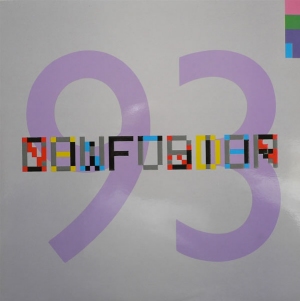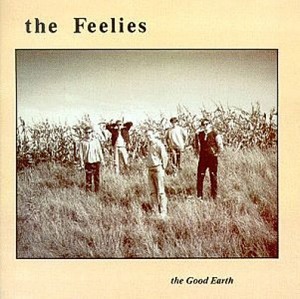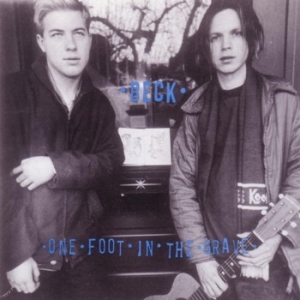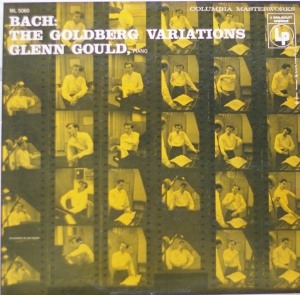|
How great are Amazon wish lists? I no longer have to feel guilty about having relatively esoteric tastes when it comes to gift-receiving, since the givers, in this case my in-laws (thanks!), don’t have to track down some hard-to-find LPs. There are limits to what you can find on Amazon, of course, but I enjoy hunting the out-of-print albums, so in-print albums or recent reissues make a nice foundation.
124. The Dead Texan – The Dead Texan CD+DVD – Kranky, 2004

I just finished writing my entry for The Dead Texan for my decade-end album list (spoiler alert!), which means three things: first, I enjoy the album a great deal; owning it was long-overdue; and it’ll be difficult to write about the album without rehashing everything I just wrote. Instead I’ll focus on an aspect of this release that I failed to mention in that blurb: the accompanying DVD. Consisting of seven videos done by Christina Vantzos and Adam Wiltzie, the video portion is very pleasant, if not as memorable or affecting as the music, although I suspect that wasn’t the aim. The repeated motifs, casual animation, and vivid colors are more of a jumping-off point for your own imagination. If only MTV had a late-night show like 120 Minutes/Subterranean for ambient music, but that seems rather unlikely. You can watch a number of these videos on YouTube, including “Aegina Airlines,” “The Six Million Dollar Sandwich,” and personal favorite “The Struggle,” although none of them quite match up to this fan-made clip of Stars of the Lid’s “Requiem for Dying Mothers, Part 1” starring Alf.
125. Tom Waits – Swordfishtrombones LP – Island, 1983

I own three albums from earlier in Tom Waits’ career (Closing Time, Nighthawks at the Diner, and Foreign Affairs) and I’ve heard a few of his later junkyard-percussion and gravel-voiced albums (Rain Dogs and Mule Variations), but I hadn’t ventured into a commitment with any of them for a very specific reason: I know when I should listen to Tom Waits, but I’m never in that situation. Here’s the ideal situation for putting Tom Waits on my turntable: it’s 3am, I don’t know what day it is, I live in a musty apartment above a bar in run-town part of town, and I am drinking whiskey. Oh, and I’m heartbroken, but it’s been a while since the break-up, so it’s a more general sense of heartbreak. That’s the perfect storm for Tom Waits, as I imagined it, and the odds of it ever happening for me are about one in eight million. Yet Waits seems so perfect for that mood that I’ve struggled to find a replacement setting.
This morning I gave up trying to match Waits to the proper mood and put my newly acquired copy of Swordfishtrombones on the turntable. It’s 11am on a Saturday morning in December. I’m wrapping presents for my wife and watching USPS trucks swarm the neighborhood. It’s a far cry from the parade of misfits Waits invokes, but these songs still manage to set their moods. I expected a greater emphasis on the clanging, junkyard songs, but what impressed me so much about Swordfishtrombones on my first listen was the variation. The instrumentation, the production values, the moods, the vocal styles—the album switches character from song to song, yet still holds together. This feeling sunk in when “Town with No Cheer” and “In the Neighborhood” closed out side A. Those songs are closer in spirit to his earlier recordings, but the mix, the lyrics, and the delivery all separate them.
What hasn’t sunk in yet is the content of the songs. There’s no lyric sheet included with this reissue of Swordfishtrombones—I don’t know if there ever was one—and a few of Waits’ more dramatic vocal inflections prevent easy transcription of his words. The recourse for this issue may be David Smay’s 33 1/3 book on the album, which I’ve added to my to-buy list, but until then, I’ll give Swordfishtrombones a few more listens to iron out the details. I’ve long respected Tom Waits for being such a profoundly original artist, but Swordfishtrombones marks the first time that my respect wasn’t accompanied by an equal level of distance.
126. The Feelies – Crazy Rhythms LP – Bar None, 1980 [Reissue]

I’ve listened to Crazy Rhythms a few times over the years, most recently in conjunction with my post about its 1986 follow-up, The Good Earth, but it’s never fully sunk in. I understand the appeal of the record—it’s an inspired blend of post-punk, new wave, and the nascent strains of college rock—but transitioning that recognition into genuine fondness has been tricky. Here’s my theory: I’ve encountered all of their typical elements too many times outside of the context of this specific band to be surprised by them. Mid-fi production values, hyper-strummed clean guitars, casually melodic vocals that occasionally skip toward an impassioned yelp, a live-sounding drum kit; all of these elements have filtered down into later indie rock bands as building blocks of the sound, particularly in the 1980s but also (more selectively) in the 1990s and 2000s, so their combination here sounds too familiar. The Good Earth sounds more stereotypically college rock, in part because that sound officially existed by the time of its release, in part because the group’s rhythm section had changed and was less idiosyncratic. Yet that record doesn’t carry the same acclaim as Crazy Rhythms, an album I could no longer ignore now that there’s a nice vinyl reissue out.
Scott at Pretty Goes with Pretty also recently picked this album up, having noted its countless references in Dean Wareham’s Black Postcards memoir, which I’d also read late this summer. He primarily discusses the Feelies’ peers in the 1970s, namely Talking Heads and Devo, both of which make sense as points of comparison, but the key word he uses in relation to Crazy Rhythms is “hypnotic.” That’s the quality that’s stuck out to me as I keep flipping the slab of vinyl over. The rhythm section is both jittery and insistent, the fast-strummed guitars sound like 33rpm parts played at 45rpm, and Glenn Mercer’s vocals often chant lyrics fast enough to sound like an incantation. It’s a recipe for a rapidly vibrating hypnotic disk. The other point that Scott made that clicked with me is that it takes a few listens for songs to differentiate themselves from the whole, likely because of the hypnotic quality I just described. Yet after a few listens, I’m itching to hear specific songs again (“Loveless Love,” “Moscow Nights,” “Raised Eyebrows”). Perhaps Crazy Rhythms was a grower all along, but my advice would be to give it a few extra spins before passing judgment.
|
1. Birdsongs of the Mesozoic - Magnetic Flip - Ace of Hearts, 1984

Why I Bought It: I grabbed this LP along with a handful of other post-Mission of Burma releases by Roger Miller, knowing little about it beyond Miller’s participation.
Verdict: Magnetic Flip attempts to merge Burma’s artier elements with modern classical compositions, bridging the gap between Miller’s stay in music school and his punk rock band. Using a forceful array of piano chords, organ leads, guitar textures, and drums, Birdsongs of the Mesozoic appropriate the Terry Riley/Steve Reich school of modern composition for a rock context, even naming one of the LP’s finest tracks “Terry Riley’s House.” A few of the songs touch upon Brian Eno’s instrumental work (according to Wikipedia, the band covered Eno’s “Sombre Reptiles”), giving an often claustrophobic mix room to breathe. The end result is intriguing, but often sonically overwhelming. I could have done without the reimagining of Stravinsky’s “(Excerpts from) The Rite of Spring,” which loads on too much dramatic tension for the already-laden aesthetic blueprint to stand, and the cover of the “Theme from Rocky and Bullwinkle” is curious at best. While I can appreciate the importance of forming an instrumental group in the early 1980s to push the boundaries of what independent/underground music could entail, I’d ultimately rather listen to Mission of Burma or Terry Riley than a combination of the two.
2. New Order - Confusion - Factory, 1983

Why I Bought It: In addition to my subconscious desire to hear four version of the same New Order track, I enjoy the graphic design of Factory sleeves and Confusion is no exception.
Verdict: “Confusion” isn’t my favorite New Order song, but having an instrumental version of it allows me to avoid one of Bernard Sumner’s most vacuous lyrics, “Ask me no questions, I’ll tell you no lies.” Additionally, the emphasis on electronic dance music in “Confusion” (DJ/hip-hop producer Arthur Baker had a hand in its composition) justifies the inclusion of a beats-only version and an instrumental version, which, amazingly enough, are noticeably different. The sleeve isn’t nearly as cool as the “Blue Monday” floppy-disk homage, but matching that iconic sleeve is a tall order.
3. The Feelies - The Good Earth - Coyote, 1986

Why I Bought It: While I’ve never reached the point of obsession with the Feelies’ heralded debut Crazy Rhythms, I enjoy the record enough to try out its follow-up.
Verdict: The Good Earth starts off with a handful of relatively non-descript, jangle-heavy college-rock songs. While these songs are sonically inoffensive, they sound less like a band influencing their peers (namely R.E.M.) and more like a band being influenced by their peers, perhaps one playing catch-up after six years had passed since the release of Crazy Rhythms. Glenn Mercer’s vocals tend to settle into the music rather than peak nervously above it, the guitars rely too much on standard chord progressions, and the rhythms—even with two drummers—don’t match up with its predecessor’s namesake. Starting with the fourth track, “Slipping (Into Something),” the record shows signs of life. “Slipping (Into Something)” spreads out over six minutes, emphasizing its dueling melodic leads over the occasional jangle before accelerating into a fever pitch. “When Company Comes” returns to jangle mode, but the absence of percussion is a relaxing end to side A. Side B is consistently good, with highlights like the rhythmic pulse of “Two Rooms,” the electric leads of “Tomorrow Today,” and the quiet burn of the aptly titled “Slow Down.” Isolating these interesting elements of the Feelies’ sound helps me appreciate Crazy Rhythms more, since those elements comprise the vast majority of that album rather than the highlights of certain tracks. Still, for what seemed to be standard 1986 college rock midway through side A, The Good Earth has a great deal to offer beyond a new gateway to its superior predecessor.
4. Beck - One Foot in the Grave - K, 1994

Why I Bought It: It’s significantly harder to find cheap, used vinyl pressed after 1990, so whenever I see anything resembling indie rock I’ll snap it up, particularly, like in this case, if I think it could be worth something on eBay. (While this record sells for up to $30, unfortunately there’s enough of a scratch on side A to prevent me from selling it.) I’ve never been a Beck devotee, but considering that my primary reason for this stance—my perception that Beck values style over substance in his genre-hopping exercises—doesn’t apply to a primarily acoustic endeavor, One Foot in the Grave might help me turn the corner on his work.
Verdict: Most of One Foot in the Grave sticks to a traditional folk/blues blueprint, relying heavily on Beck’s vocals, acoustic guitar, rudimentary drums, and the occasional counterpoint of K Records/Beat Happening honcho Calvin Johnson, who also produced the album. The few tracks closer to the lo-fi hodge-podge of Beck’s other early records linger on side A, which I listened to after the more stripped-down side B. There wasn’t a watershed moment of Beck appreciation, although I enjoyed “Girl Dreams,” “Hollow Log,” and “Asshole” (the lyrics of which were scribbled on the inner sleeve by the previous owner). I’ve admittedly had more fun skimming the Amazon reviews of the record, which sway from five-star odes to Beck’s “naked” album to poorly written one-star scoffs at its fidelity authored by “a kid” to this gem of a confused response, which is funny regardless of its possibly satirical intent. Where do I fit in to this glorious array of criticism? If One Foot in the Grave had been recorded in, say, 1997, after the success of Mellow Gold and Odelay, I would question its authenticity, tossing it aside as a cred-building exercise. But the timeline of its release is generous to Beck. Instead of figuring as a response to his musical surroundings or perceived audience demands, One Foot in the Grave comes off as a document of pre-stardom necessity. While the record is bolstered by Calvin Johnson, Presidents of the United States of America guitarist Chris Ballew, and Built to Spill drummer Scott Plouf, its appeal boils down to the limitations imposed by coffee houses and open mic nights. And honestly, I don’t frequent such establishments searching for the next Dylan, so I’ll take a handful of the better tracks and move along.
5. Glenn Gould - Bach: The Goldberg Variations - Columbia Masterworks, 1956

Why I Bought It: Two separate anecdotes: The first time I heard Glenn Gould’s name was when I read Giorgio Agamben’s The Coming Community in an Agamben/Kristeva seminar during graduate school. Agamben mentions Gould in a section about potentiality, essentially stating that Gould’s retreat from live performance into the studio emphasized the capacity to perform and not perform at the same time. (I could relate this concept more fully, but I’d rather avoid scouring my hard drive for a short paper on the topic.) Shortly after this instance, my mom read Gabriel Josipovici’s novel The Goldberg Variations and asked me if I could track down a copy of its musical namesake. After downloading a harpsichord rendition of the piece (the instrument the piece was written for, but I shudder at the thought of hearing a harpsichord), I grabbed Glenn Gould’s piano performance. A few months later I found the LP.
Verdict: Given that I hadn’t heard Glenn Gould’s name until a year ago, I won’t embarrass myself by critiquing his performance or J. S. Bach’s composition, although according to Wikipedia Gould himself “later came to criticize his early off-beat and lyrical interpretation, expressing reservations about its pianistic affectation, overt emotionalism, and lack of temporal unity.” I mean, I hadn’t even thought to do any of that. For my purposes, The Goldberg Variations is too busy to accompany reading, since the thirty separate variations switch up the pace frequently enough to gain my attention. Damn you, Bach and Gould, for daring to pull my attention from The Trouser Press Guide to ’90s Rock. It’s hard not to be impressed by both composer and performer, however, so I’ll continue to pick up Gould performances on the cheap—I have at least one more in the queue—but finding the right time to listen to them may be the biggest challenge.
|
|

